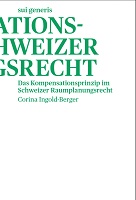Das Kompensationsprinzip im Schweizer Raumplanungsrecht
Abstract
Again and again there are demands on the land that are understandable, but are hardly compatible with the constitutional goals of economical land use and separation of building areas and non-building areas. In such situations, compensation mechanisms offer means of making certain activities possible. Compensation mechanisms have now become established in various areas of spatial planning law, particularly in connection with the use of crop rotation areas and in zoning without proof of need. As part of the second stage of the RPG revision, the so-called A compensation mechanism will also be introduced in the “planning and compensation approach” for buildings and facilities outside the construction zone. In addition to opportunities, this also entails risks. Immer wieder gibt es Ansprüche an den Boden, die zwar nachvollziehbar sind, mit den verfassungsrechtlichen Zielen der haushälterischen Bodennutzung und Trennung von Baugebiet und Nichtbaugebiet aber kaum vereinbar sind. Kompensationsmechanismen bieten in solchen Situationen eine Handhabe, um gewisse Tätigkeiten dennoch zu ermöglichen. Kompensationsmechanismen haben sich heute in verschiedenen Teilbereichen des Raumplanungsrechts etabliert, so namentlich im Zusammenhang mit der Inanspruchnahme von Fruchtfolgeflächen sowie bei der Einzonung ohne Bedarfsnachweis. Im Rahmen der zweiten Etappe der RPG-Revision soll zudem mit demsog. „Planungs-und Kompensationsansatz“ für Bauten und Anlagen ausserhalb der Bauzone ebenfalls ein Kompensationsmechanismus eingeführt werden. Neben Chancen birgt dies jedoch auch Risiken.
Keywords
Kompensation,Realkompensation,Fruchtfolgefläche, Bodenaufwertung, Pla-nungs-und Kompensationsansatz, Gebietsansatz, Bauzonengrösse, Einzonung, AuszonungDOI
10.38107/045ISBN
9783907297452Publisher
sui generis VerlagPublisher website
https://suigeneris-verlag.chPublication date and place
Zurich, 2023Classification
Law


 Download
Download Web Shop
Web Shop